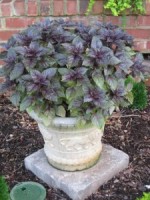 Every year I grow more basil than all other herbs combined. I start seeds before the first frost and have a huge germination rate so end up planting a big pot near the kitchen door plus a row in the vegetable garden. It gets lots of water all season long and I fertilize it with a soluble all purpose fertilizer every couple of weeks. If I forget the leaves tend to get pale green and then yellow so I am reminded of my duties and can correct the situation.
Every year I grow more basil than all other herbs combined. I start seeds before the first frost and have a huge germination rate so end up planting a big pot near the kitchen door plus a row in the vegetable garden. It gets lots of water all season long and I fertilize it with a soluble all purpose fertilizer every couple of weeks. If I forget the leaves tend to get pale green and then yellow so I am reminded of my duties and can correct the situation.
Once the plants get to be about 8” tall I harvest the leaves on a regular basis by cutting off the top leaves, causing the plant to branch and preventing the flowers from forming. If flowers are allowed to form the plant declines and the leaves can get bitter so harvesting serves an important function. Needless to say I usually have a large supply of basil on hand during the summer so we eat a lot of pesto. I also have bags of pesto in the freezer so I can feed my pesto craving all winter, or at least into the fall. All through the summer I have a vase of fresh basil sitting on the kitchen counter (basil turns black if stored in the refrigerator) so its easy to use at all times. We eat it in salads and use it as a garnish for almost anything we want to garnish.
 In addition to growing basil for use in the kitchen, I usually start some purple leaved plants too. I have had much better luck with ‘Opal’ than ‘Purple Ruffles’ which tends to go green for me within weeks of germination. The flavor of ‘Opal’ is great but I use the plant primarily in my flower beds where it is a knock out with pink patio rose and elsewhere with bright yellow marigolds. I pinch it back to get it to branch and become bushy and snip off any flower shoots until fall when I actually rather like the tiny pink flowers that are produced. Purple foliage is always an asset in the garden and is equally pleasing in flower arrangements so.
In addition to growing basil for use in the kitchen, I usually start some purple leaved plants too. I have had much better luck with ‘Opal’ than ‘Purple Ruffles’ which tends to go green for me within weeks of germination. The flavor of ‘Opal’ is great but I use the plant primarily in my flower beds where it is a knock out with pink patio rose and elsewhere with bright yellow marigolds. I pinch it back to get it to branch and become bushy and snip off any flower shoots until fall when I actually rather like the tiny pink flowers that are produced. Purple foliage is always an asset in the garden and is equally pleasing in flower arrangements so.
Type: Annual herb.
Bloom: White or lavender ½” long flowers in summer.
Size: 6-60” H x 24-36” W (depending on variety.)
Light: Full sun.
Soil: Fertile, moist, well drained.
Fertilizer: Apply a water soluble all purpose fertilize every 2-3 weeks during the growing season. Avoid high nitrogen lawn fertilizer as it will hurt flavor.
Hardiness: Not frost hardy and germinates best at temperatures between 75 and 85 degrees.
Care: Pinch back or harvest terminal leaves; cut off any stems that appear to be bearing flowers; keep foliage dry to avoid rot.
Pests and Diseases: Susceptible to several fungal diseases including damping off, leaf spot, and crown rot.
Propagation: Seed.
Companion plants: Tomatoes and peppers (basil is said to enhance their growth and impart its flavor to nearby tomatoes); purple leaved varieties look good with pink, orange, or yellow flowers such as roses, or marigolds; low growing, fine textured ‘Spicy Globe’ is a good annual to substitute for boxwood.
Outstanding Selections: N.B. There are over 100 kinds of basil.

-
- ‘Genovese’ (most commonly grown for culinary use)

-
- ‘Opal’ (purple, 2’ tall)

-
- ‘Spicy Globe’ (green, 6-12” H)

-
- ‘Cinnamon’ (like ‘Genovese’ but with cinnamon flavor)

- Lemon basil (O. americanum)
